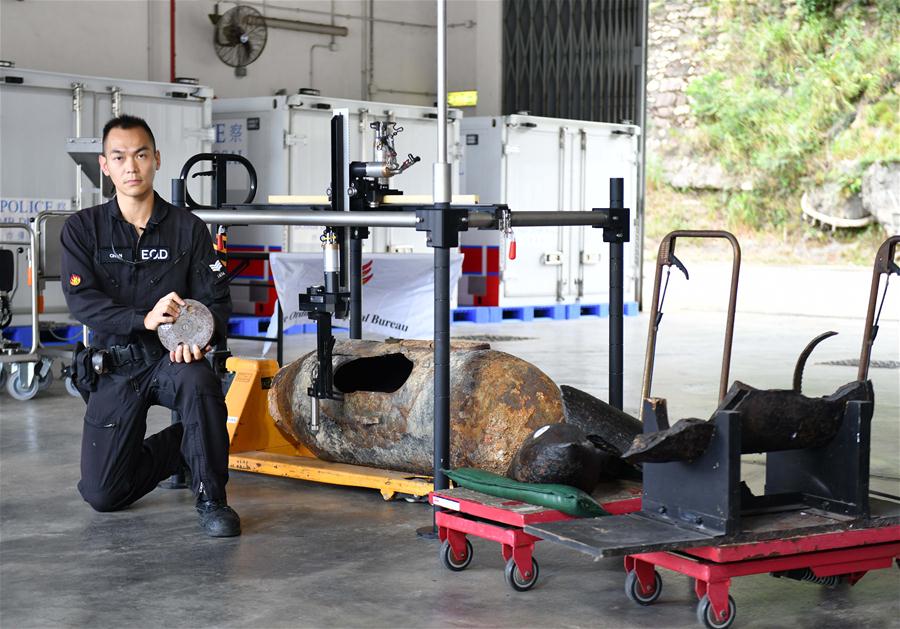
A bomb disposal officer of Hong Kong police presents the removed fuse of a bomb in Hong Kong, south China, Aug. 7, 2020. (Xinhua)
HONG KONG, Aug. 15 (Xinhua) -- Bomb disposal is known as "the long lonely walk" for its danger and difficulty. In Hong Kong, bomb disposal experts work on a "one-man risk" principle, which means the least people bear the greatest risk.
Suryanto Chin-chiu, 43, is the one.
For him, who has been in the police bomb squad for over a decade, dealing with unexploded armaments that date back to the Japanese occupation of Hong Kong in World War II (WWII) is probably the most thorny and challenging.
From rifle bullets and grenades to aerial bombs weighed nearly 1,000 kg, dangerous weapons left from WWII have been discovered repeatedly over the past decades at busy commercial districts, construction sites, and even the seabed.
"I personally have handled no less than 100 cases concerning such ordnance," Suryanto, bomb disposal officer of the police's explosive ordnance disposal (EOD) bureau, said.
Founded in 1972, the bureau is responsible for disarming various types of explosives and tackling chemical, biological, radiological, and nuclear incidents. "Out of our roughly 150 operations each year, about a third are related to wartime weapons."
The Japanese army took over Hong Kong for three years and eight months starting Dec. 1941, during which the place was ravaged by continuous battles.
After the warfare, Hong Kong began its rebuilding, with wrecked mansions renovated and large infrastructure projects launched. From time to time, wartime explosives were unearthed by construction workers or detectorists. A lion's share was in Hong Kong Island, the hardest-hit area in wartime.
The latest discovery was a 1.3-meter-long bomb on July 16 of this year at a construction site in Kai Tak, where there used to be an airport of the British Royal Air Force.
"Our tests showed the explosive composition of some wartime bombs is still valid, which means they are almost as powerful and lethal as over 70 years ago," Suryanto said.
Suryanto still clearly remembered the power of a 225 kg air-dropped bomb uncovered at a construction site nearby Queen Mary Hospital more than 10 years ago, which blast unexpectedly after the EOD members cut into its surface and destroyed its gunpowder by burning.
The explosion, causing no casualties as people related had evacuated, left a big hole at its epicenter, damaged buildings of the hospital and triggered fires at multiple places.
Another time, a shell with 90 kg of high explosives was detonated by bomb disposal experts on a hill in Central and Western District on a rainy day.
Suryanto recalled that the upward current caused by the explosion stopped the rainfall for 10 seconds and caused a brief wave of hail. "At first we thought it was the shell fragments that were falling and hastened to find shelters. But then we realized it was hail," he said.
To defuse a bomb consists of strict procedures, in which a single move can determine life or death. "We have a proverb, 'Getting it right. Every time,'" Suryanto said.
Taking aerial bombs for example briefly, the EOD experts first excavate the bomb completely, no matter it is in the sea or embedded in the ground of the construction site. They carefully clean the cover roughly and identify the detonation mechanism. Then the metal casing of the bomb will be drilled by a water jet cutter to reach and destroy the explosives.
Despite the wartime ammunitions have remained silent for long, experts said it is far more dangerous to eliminate them at present than doing so seven decades ago as chemicals within the metal casings have turned increasingly unstable with time passing by.
Suryanto sees the handling of Japanese bombs as the riskiest to bomb squad members. Because of limited materials and the technology, those weapons are more likely to trigger an unexpected explosion than those made by Britain or the United States, he said.
However, compared to personal safety, Suryanto cares more about the life and property of Hong Kong residents, which is at the center of every bomb disposal operation.
Three AN-M65 aerial bombs weighed 450 kg were found one after another in the same construction site of Shatin to Central Link in a few months in 2018. Bomb disposal experts estimated that such a bomb, if exploding, would be equivalent to about 4,000 grenades detonated at the same time.
Before defusing one of the bombs, more than 10,000 people in the residential and commercial buildings nearby had been evacuated. A bomb disposable officer and his assistant, backed by a supportive team, worked for nearly 30 hours straight to disarm the bomb.
"It often takes 20 to 40 hours to defuse a wartime bomb," Suryanto said.
Bomb disposal, as the most dangerous operation of Hong Kong police, gives every squad member a sense of mission and responsibility.
"In addition to the ability to learn and apply professional skills, a bomb disposal expert should be willing to touch these dangerous explosives, which means when everyone else chooses to stay away, you will not hesitate to step forward to deal with them," Suryanto said.
The mission of them will not end until all the unexploded wartime bombs are discovered and defused. Suryanto estimates there are still quite a number of unfound weapons out there.
Shouldering the heavy responsibility, he has never felt scared during operations. If there is any emotion, it is the relief and joy when a bomb is eliminated and all the people are secured, he said.
"It is the most gratifying moment and every time I am happy to laugh," he said. Enditem



